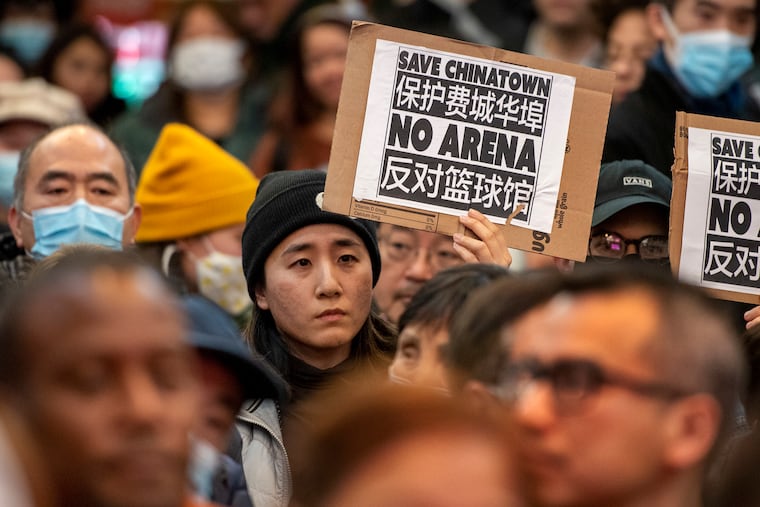On Sixers arena and beyond, Philly must dream big
Bowing to the demands of every self-appointed guardian of every neighborhood will doom any major new project.

Cities are always changing. It’s a fact of life, and it’s also usually a good thing. The dynamism of cities is what helps them remain compelling places to live and work.
There have always been some Philadelphians who hear bold visions of what the region and city can be and say yes to them. There has also always been another group — often louder, if not bigger — that wants to say no and settle for the status quo. The fight over the proposed Sixers arena is another battle in the war between the two, another chance to see whether Philadelphia wants to walk boldly into the future or sit comfortably, content with our past glories.
Much has already been written about the project, in these pages and elsewhere, and much about the exact details has not yet been decided. But public reaction to the arena fits already into a pattern of Philadelphia’s can’t-do attitude. Big plans in Philadelphia are too often met with a litany of reasons why they can’t or shouldn’t happen.
To be fair, city officials have already attempted several changes around the proposed arena site on Market Street. In 1977, it was building the Gallery. Suburban shopping malls sucked commerce from Center City, so the city took the mall concept and brought it downtown. It was a big plan (including some big government funding through the Philadelphia Redevelopment Authority), and it actually worked — for a while.
» READ MORE: Sixers arena proposal should not be a zero-sum game | Editorial
In conjunction with the Center City commuter connection that joined the two halves of the city’s rail network, it represented Philadelphia’s last great era of change and rebirth. Even the new rail connections never brought suburban customers back to Center City in the numbers the Gallery’s promoters envisioned, but the mall was fairly successful for a time.
By the late ‘90s, though, it had already seen better days. The Pennsylvania Real Estate Investment Trust bought the Gallery in 2014, and after massive renovations — and a massive tax break — relaunched it as the Fashion District. This was less “thinking big” and more “old wine in new bottles,” and it wasn’t a great vintage. The latest version of rebuilding Market East involves the Sixers’ proposed arena taking the place of part of the Fashion District.
The first point in the arena’s favor is that, unlike many civic projects, this one will not require the taxpayers to foot the bill. Public stadium and arena funding has been criticized as wasteful and corrupt for decades. Here, those complaints are answered: The wealthy owners of the Sixers will pay for the whole $1.3 billion cost themselves.
Transportation is another issue. Green-minded people hate the sea of parking lots that surround our modern sports venues. Here, the problem is solved by placing the arena atop the nexus of train, subway, and bus lines at Jefferson Station. There is no place in the city better accessible by mass transit.
Opposition to the arena is sometimes contradictory. Economist Andrew Zimbalist told The Inquirer, “Here you are right smack in the middle of downtown, and the arena, it’s dark 220 days?” But this is a worst-case scenario that assumes the arena will never host anything but regular-season Sixers games. At the same time, the Philadelphia Chinatown Development Corp. says the arena will bring too many changes to the area, including traffic, parking problems, and “the deterioration of Chinatown culture.”
The opposition from the PCDC is not too surprising. Its mission is “to preserve, protect, and promote Chinatown as a viable ethnic, residential, and business community.” In practice, that has translated into opposing every outside development in the neighborhood — or even near the neighborhood — from the Pennsylvania Convention Center to the Phillies stadium proposed for 13th and Vine Streets two decades ago.
» READ MORE: Let’s say no to the Sixers arena plan, which threatens to gentrify Chinatown into extinction | Opinion
It’s understandable to want to preserve a neighborhood that you value. Sometimes it gets called “historic preservation,” sometimes it gets called “NIMBYism.” In this case, it’s preserving a “viable ethnic community.” But it all amounts to an attitude of never changing anything in a world where things are, in fact, constantly changing.
This kind of reactionary attitude doesn’t fit simply on the left-right division of politics. But the left-right axis does determine public response to it. If the arena were proposed for Mayfair or Roxborough and residents there spoke of preserving a “viable ethnic, residential, and business community,” the reaction from politicians and the press would be quite different.
Neighborhoods are always in flux. If you grew up in the city, as I did, you have seen it with your own eyes. Whether each change is good or bad is in the eye of the beholder. But no one owns the city. No one can point to a time in history and say, “This was the time the neighborhood was good. No change can deviate from this.”
Philadelphians are dreaming big again with the arena and with projects like the Roosevelt Boulevard subway. To make those dreams come true, we must realize that bowing to the demands of every self-appointed guardian of every neighborhood in the vicinity will doom any project.
Letting Philadelphia grow again requires the courage to say yes.